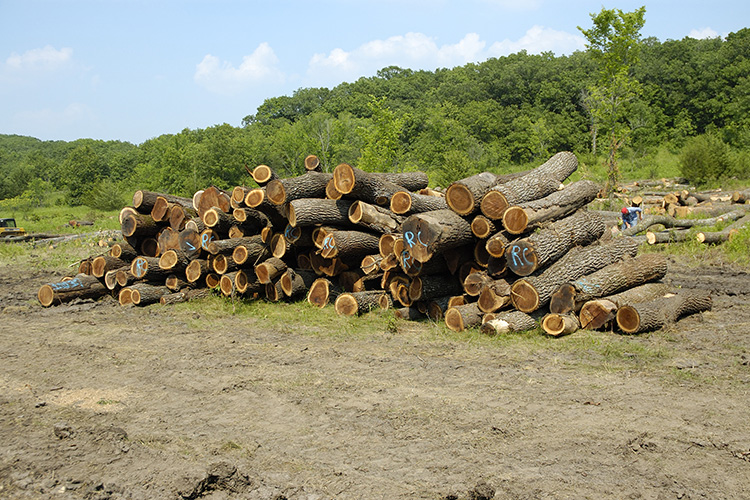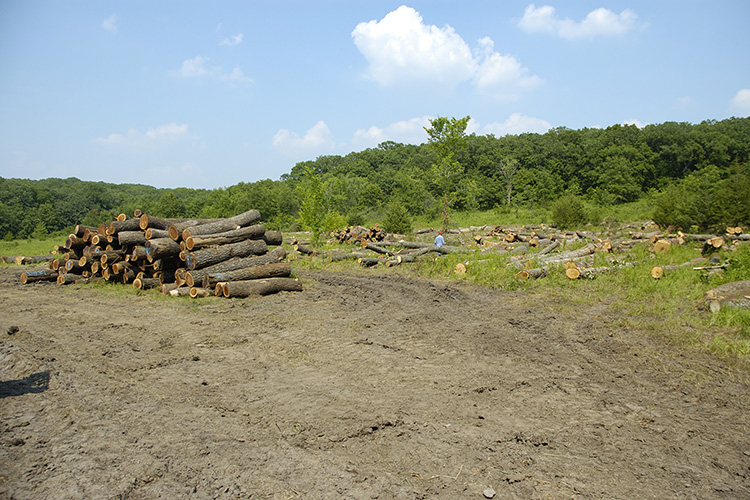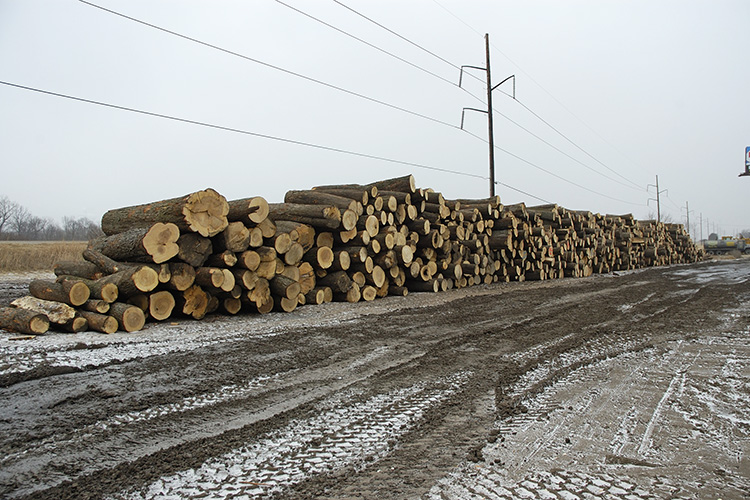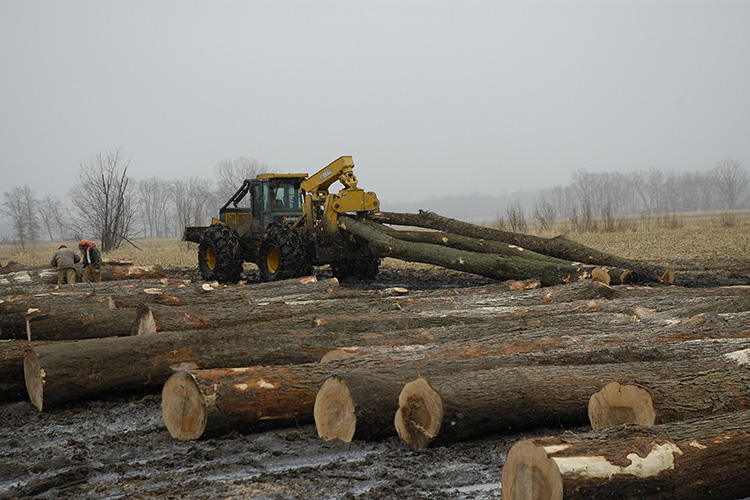We now have 960 acres spread out over a 150-mile area. My goal in buying the two outlying properties (about 400 acres of land) was to resell them when the time came to purchase more land closer to our home. This installment is all about harvesting timber on investment properties.
The time to sell came sooner than I expected and now I have to scramble to get those properties managed and ready to sell so I can execute the option I have with Larry Kendall on 400 acres next to the Home Farm.
The first step is to sell the mature marketable timber on those two outlying tracts.
SELLING TIMBER
This will be hard to condense into a small enough package for this blog format, but I will give it a try.
Though I had bought the 240 acres and the 160-acre island at more or less the same time in early 2007, it took me a while to get the island ready for logging. I started on the 240 tract first.
HARVESTING TIMBER ON THE 240 ACRE TRACT
I had learned my lesson when I sold the timber off the Home Farm back in early 2006. I had no idea when that job ended if I had gotten a good deal or not.
Further I had no idea if the logger had shafted me. Like I said, there are honest and dishonest people in every business, but there just seems to be more dishonest ones in the logging business.
The logger didn’t like the idea of competitively selling the timber. There was a very noticeable lack of transparency. I couldn’t see through the deal and that made me nervous.

A stack of walnut logs taken off the 240 acre property. That property had a good number of decent sized walnut and that was the bulk of the value from this timber harvest program.
I learned later that the local mill was actually financing the logger’s operations. The “logger”, in this case, was a middleman. He wasn’t the cutter.
The mill was paying the cutters and the truckers with the agreement that they would be buying the logs at their “market price”.
So, in effect, the logger I was dealing with had only one place he could sell my logs.
I thought we had a nice “grade and yield” program in place, where I got 75% of the price for which the middleman (the logger) sold the logs, but I didn’t realize he had only one place he could sell them.
Anytime you remove competition from the pricing scheme you open yourself up for problems. Not saying for sure that I got taken, but not knowing if I did or not had a bad feel of it.

My utilizing the large opening in the middle of the farm, we could reduce the length of the skid and make the timber harvest go quicker. In addition to the walnut, I also cut out some of big pallet wood trees, such as several large cottonwoods, to open up the canopy.
So rather than go through another sale similar to that one, I decided to be the crew chief – the middleman, so to speak. I would hire the cutters and sell the logs on the landing to the highest bidder.
But to do that I needed help. This whole process was blessed and as further proof of that fact, I had started talking to a log buyer for a big mill three hours away regarding the maple trees I wanted to sell on the island.
This guy was bluntly honest with me and walked me through everything. Mike, to his credit, took tons of time to teach me how to run my own timber harvest and sale.
Mike wanted the walnuts off the 240 acres, and I was more than happy to sell them to him because he was offering a great price.
So, he did have a chip in the game, a reason to see me succeed. But he still went above and beyond the call of duty spending way more than 100 hours teaching me the ropes.

I hired a fellow to “pre-haul” the logs from the large opening (which I eventually cleared and made into a food plot) up to the main landing at the road where the semi would load them out. Pre-hauling adds to the expense of the job, but can greatly reduce skidding time for the cutters, which makes the job go faster.
When the project was done in early summer of 2007, I had made a decent amount on the trees.
I focused on harvesting walnut, some big bur oak and large cottonwoods to open up the canopy to make the timber thicker. In the process I learned a ton about the logging business.
Better yet, I knew the process was clean because I sold the logs to the highest bidder and had my check in the bank before the logs left the landing.
In a perfect world, that is how this should work, but it was very labor intensive on my part.
I am not 100% sure I would do it that way the next time. I would have to think about it. But the key is knowing that the deal is fair, with complete transparency.
So now it is mid-spring of 2007. I have the timber off the 240 acres, and I have hired my neighbors to bring in heavy equipment and create a trail system, as well as bulldoze a couple more small food plots.
I then rented some equipment and planted the plots. For all intents and purposes, by mid-summer of 2007, this property is done, ready to sell.
HARVESTING TIMBER OFF THE ISLAND
As I mentioned in Part Three of this series, I decided to sell the maple logs from the island to a large mill in a nearby city.
However, we had not settled on exactly what that deal would look like. I really wanted to maximize the amount of money I could get for those logs since that was the real value of that property.
Being in the flood plain, I didn’t really expect to sell the land for much more than I bought it for, so if I was going to make money it would be on the logs.
I still had a deep curiosity about the potential of the deal the original logger had presented – I wanted to sell boards instead of logs.
I mentioned that deal to the log buyer for the big mill. Mike just laughed and said I would need to talk with the owner on that one.
So, a few weeks after closing on the property in early 2007, I drove the two hours over there and sat down to lunch with the mill’s owner.
He really wanted those trees for his ongoing soft maple order and there was even more to it. The casket company who was buying the maple boards only bought white wood.
Maple logs usually have a brown core and the larger the log, the smaller the brown core is as a percentage of the total log.
The mill’s log buyer was always looking for big maple trees (or cut logs) so they could get plenty of white boards. That’s what I had on that island – big trees, that presumably would yield a lot of white wood.
By the time I was done with lunch, I had convinced the mill owner to go with the same deal I had planned for the original logger.
I would own the logs. I would pay to have them cut, skidded and trucked to the mill. I would then pay the mill a custom cutting fee of, I think, $.27 per board foot. The mill would sell the boards and take a 15% marketing fee for selling them.
The deal was interesting for both of us. I got to make more money, though I had to take more risk and I also got to learn a ton more about the entire process.
They got boards to sell with zero risk. I am not sure I would do this again, either, but it sure looked like a winner on paper.
Like the timber sale on the 240-acre tract, this one would require tons of time on my part to oversee each phase since I was now the crew chief.

My logs as they were piled in the yard at the saw mill shortly before the completion of the trucking. The mill kept my logs separate and then sawed them all in one batch so the boards could be kept apart from their regular inventory.
When I finally get around to selling the island I will go into more detail on the numbers. It was really interesting how this one played out. More about that later.
Having trees on an island and getting them to a sawmill are two totally different things. The guy that sold me the island knew I was going to harvest the trees. I never hid that fact. I bet he was grinning at the challenges I now faced.
I am thinking that if it had been clear and easy, he would have harvested the trees himself.
Worst case, I knew I could hire someone to transport the logs off the island using a small barge. That would be really expensive, so I had to find a better way.
My first step was to contact the Army Corp of Engineers who manage that river. Maybe they manage all rivers, I am not sure, but that was the agency I had to work with now.
“What are my options for getting a log skidder out to that island?” I asked.
The engineer quizzed me for a few minutes and then on learning that there were WRP (Wetland Reserve Program) acres on the island (a converted farm field that was designated as wetland) he told me I could get out there any way I wanted.
He said that having part of the island in farmland, and now a government program, grandfathered in any access method that had been used to get to the island in the past and opened the door for anything I needed to do to get equipment out there.
I asked him if I could build a bridge, and he said yes. I asked if I could build a stone crossing. Again, the answer was yes.
But when I asked if they provided technical expertise, he told me they did not and suggested that I hire a private consultant or figure it out myself.
I knew I needed some kind of reasonably permanent access to the island if I was ever going to sell it. Any eventual buyer would no doubt want to be able to plant food plots on there so he could turn it into a whitetail mecca.
I thought through everything from salvaging an old bridge to driving steel I-beam piers and building a bridge on those.
After a lot of thought, I figured a bridge would be apt to eventually wash away. I opted for a simple stone crossing. But even that was easier said than done.
The side channel that separated the island from the mainland was about 60 yards wide and maybe 10 feet deep.
There was an old crossing in this flowage, but it was under about five feet of water. Fortunately, it still had a good solid base. This must have been how the farmers accessed the island a couple of decades before.
I had to build up that crossing. To get to the other side, I was going to need a lot of rock! Sixty yards long, by five feet deep by roughly 10 feet wide = at least 9,000 cubic feet not considering what we would need for solid entry and exit ramps on both ends.

This is the aftermath in one of the more heavily cut parts of the island. You can still see plenty of trees left and the open canopy will produce thicker growth and more browse back in the timber.
Fortunately, I found a construction company in the nearby city that had recently torn up a highway.
They had a pile of broken concrete that was about the size of a football field and 15 feet tall. They had already taken out all the re-bar, so it was reasonably clean.
They were happy to give me the material just to get it out of their yard. They had the dump trucks to haul whatever I needed to the river.
Of course, I would have to pay for the loading and trucking, which was far from cheap.
Next, I needed a way to get all that concrete pushed out into the river and solidly packed. Fortunately, I was able to find a heavy equipment rental store in the city that delivered a huge track loader.
That is basically a bulldozer with a giant bucket on the front instead of a blade.
I would have enjoyed operating it myself, but it would have taken me a good bit of time to learn the operation. Plus, I still had my day job as a writer and photographer that kept the cash flowing on the home front.
Again, I got lucky. The old farmer who had given the easement to cross his land to get to the island, back when I was buying it, happened to be a pretty good heavy equipment operator, or maybe it was his son.
Either way, they decided that the crossing was a good idea for them too, since they had a small bit of land on the island also.
Since I was paying for everything, they volunteered to run the track loader and build the crossing for free.
I don’t know how many loads it took. I was only there for part of it. I do know I had about $12,000 in trucking and another $2,000 in the track loader rental. $14,000, and a week later, I had a very nice crossing that I could drive my truck across.
The crossing was really more like a dam; and that was the idea. As long as I could make it tall enough to raise the water level of the side channel until it was no longer flowing around the island, I knew I would have something that would hold up for a while.
Plus, it had to be solid enough that a big log skidder could drag several logs across at the same time.
I bet that anyone who had fished downstream of that crossing in the past was pretty surprised when they drove up and saw it was dry!
But like anything that has to do with rivers, it was only dry for a while. If you remember what happened to the Cedar River during the flood of 2008, you know where this story is headed.
It took most of the summer of 2007 to plan the crossing. By early fall I had it completed.

The cutter I hired used a giant skidder that could bring out several full sized maple trees in one trip. You can see why my crossing took a beating during the three weeks that the cutter was working. We are staging the logs in a farm field on an adjacent landowner where the guys from the mill marked them and bucked them to length based on their needs.
As soon as the ground froze that winter, sometime in early January, the cutter I hired – a very good professional who was recommended by the mill – drove his log skidder onto the island for the first time.
Within a month, he had cut and dragged across the dam all the trees that the mill wanted.
At one point the water came up over the crossing and the cutter was forced to skid them across one at a time to keep the current from hitting multiple logs and dragging the skidder off the crossing.
After working the logs up, cutting them to length (the guys from the mill did that for me because they knew exactly what lengths they needed) I got the logs to the mill and I had done my part.
It was a stressful process, but it was a great adventure and an unbelievable learning experience.
So, now in our story, it is late January of 2008. I would love to own the island for another year so I could plant some food plots and improve the trail system just to see how cool I could make it.
But I have this pressing need now. I have to sell the property as quickly as I can in order to buy the 400 acres near the Home Farm from my friend Larry.
I will tell the story of selling these two outlying investment properties in the next two sections of this series. You can read Part Five here.
